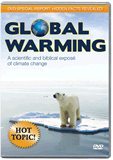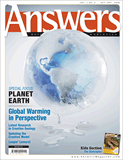Climate Alarmism
Five Scientific Reasons Not to Panic About Climate Change
Dying polar bears. Rising oceans. Massive climate refugee camps bursting with hungry and displaced families. These crises, and many more terrors, are our future if we don’t do something—and do it now (it might even be too late!). After all, “there’s no planet B.” Climate change alarmists frequently, urgently, and even angrily, pound these points to induce panic and spur citizens to action. But should we join in on the panic?
A previous article discussed four biblical reasons we shouldn’t panic about climate change. But is this an issue of “settled science”—we have no choice but to panic because of the data? Well, not so fast. As always, there’s more to the issue than sensational media claims would have us believe.
Here are five of the top scientific reasons we can remain calm and reasonable in the face of climate alarmism claims.
-
Fossil fuels lift nations from poverty. Fossil fuels provide inexpensive, reliable energy. But governments around the world support expensive climate policies that reduce fossil-fuel use. Promises of “net zero carbon emissions by 2050” might sound like a hopeful incentive, but what is not discussed is the effect these policies have on poverty-stricken communities.
Many countries import oil and other resources needed for energy production. This causes a dependency on foreign nations and fluctuating import costs. When the cost of energy increases, consumer goods and utility bills also increase. This has a direct impact on the poor because the poor spend a larger proportion of their financial budget on household items and higher utility bills than a wealthy person does. Importing these resources also means fewer jobs if countries are not producing them on their own—further reducing economic expansion. The US currently imports around 72% of its crude oil from foreign nations.1
While the US may have environmental protection for extracting fossil fuels on US soil, many foreign nations do not. Therefore, some US energy producers might claim to be reducing their carbon emissions because they are increasing the use of “green energy,” but they are actually increasing their global emissions by extracting and shipping fossil fuels from other countries with an out-of-sight, out-of-mind attitude.
When countries are able to produce their own energy, it has positive impacts on that nation’s economy. If climate alarmists are truly concerned about how environmental factors negatively influence people, there should be consistent incentives to help impoverished nations gain access to clean drinking water and energy to heat their homes instead of advocating for policies that perpetuate economic stagnation because of the fear of potential fossil-fuel emissions.
Even if the projections for man-made climate change do come to fruition...humans can thrive in any climate if they and their nation have the economic resources to do so.
Even the worst-case scenarios for climate change from the United Nation’s International Panel on Climate Change have the poor nations of the world today being richer by the end of this century than the rich nations of the world today (assuming we allow them to continue to develop, which means they need access to inexpensive, reliable energy from fossil fuels).2
Realistically, even if the projections for man-made climate change do come to fruition (more on that below), humans can thrive in any climate if they and their nation have the economic resources to do so, but they can’t survive well in a paradise on $1 a day. So what’s the greater threat? Climate change or poverty?
-
Warmer is better! Geologic evidence and proxy data suggest that the earth has been significantly warmer and has had higher CO2 levels in the past, and all sorts of life thrived. This, of course, was before the global flood a few thousand years ago which radically changed the geography and climate of the planet. But there is also evidence to suggest parts of the earth were warmer after the flood than they are today. In fact, historical records indicate there were several warm periods including the medieval warm period (MWP) between AD 900 and 1300 in which people were able to farm in Greenland—an area currently covered in ice.
Warmer temperatures can extend growing seasons, which allows for increased agricultural production. Cooler temperatures can cripple agricultural production as evidenced by the “little ice age” that occurred in 1400 shortly after the MWP. During the “little ice age,” the Thames River in London froze over and much of Britain experienced food shortages.3
When people have access to cheap, reliable energy, they are also able to heat their homes to protect themselves from the cold. Studies suggest that cold snaps are more likely to cause human death than heat waves.4 So if the world is warming, cold snaps will be reduced, and even if the number of heat waves were doubled, we’d still have a net reduction in human mortality—and that’s a good thing!
-
Panic drives bad decisions. As Christians, we understand God is in control over his creation and that we are to exercise discernment. When governments try to persuade or mandate climate policies, we should be cautious and quick to ask why. After all, some of these changes threaten to overhaul current economies and political systems, which would have far-reaching consequences (and put much more power in the hands of the government, which, historically, often has a poor outcome).
As an example of a bad decision driven by panic, consider the Paris Climate Agreement. The Paris Climate Agreement (PCA) is a legally binding international treaty adopted by 196 countries and aimed at reducing CO2 emissions and global warming to 2°C below pre-industrial revolution levels by the middle of the twenty-first century. There are two relevant numbers to consider regarding the implementation of this agreement. First, the amount of warming prevented by the end of the century and, second, the cost to the global economy. Assuming projections of this climate agreement are correct, full compliance would reduce the global average temperature by only 0.17°C by 2100.5 Realistically, such a small number has zero impact on the environment and human well-being. Now, the cost of the PCA, according to backers, is one to two trillion dollars per year from 2030 to the end of the century ($70–140 trillion total). That means a cost of $23.3–46.6 trillion per 1/10°F in warming reduction.6 The benefits don’t justify the costs!
Or what about the proposed Green New Deal? The Green New Deal (GND) is a congressional resolution to combat climate change that has been introduced by several US Representatives. The American Enterprise Institute estimated that the cost of just the aspects of the GND that are directly related to reducing CO2 emissions (retrofitting buildings, switching energy sources to wind and solar, etc.) will cost $490 billion annually.7
But that would not be the total cost of implementing the GND because it’s not likely it would get through Congress by itself. Rather, it will need a coalition of support from various groups with their own agendas (all of which cost more money). Fulfilling these likely demands would bring the estimated cost to $9 trillion annually,8 nearly half the US’ annual economic output ($20–22 trillion).
And would it work? No, the impact on temperature would be so small9 that it’s basically undetectable, thereby having no positive impact on ecosystems or human well-being.
-
The models are . . . wrong! Models regarding potential warming often have large temperature ranges. Climate policymakers, including the Intergovernmental Panel on Climate Change (IPCC), use computer-generated climate models to inform their climate change decision-making. Based on the computer-generated models, the IPCC estimates climate sensitivity—the amount the average global atmospheric surface temperature will rise in response to a doubling of atmospheric CO2 concentration—with high confidence at 1.5–4.5°C or 2.7–8.1°F.10 However, empirical data shows that CO2-caused warming is either well below, or just slightly above, the model ranges.11 Generally, these models predict two to three times more than what is observed over the relevant period.
A study comparing 38 computer-generated models to real-world observational data between 1979 to 2014 indicated all 38 computer models predicted more warming than what was actually observed.12
There is no rational basis for predications about future temperature or for policy response to such predictions.
Of course, we also don’t know that all of the observed warming came from CO2! In the past, the earth has warmed due to factors other than man-made CO2 (for example, the previously mentioned medieval warming period that occurred prior to the industrial revolution when global temperatures warmed enough that farming was possible in Greenland).
Since the climate models used by policy makers appear to inflate overall warming trends, there is no rational basis for predications about future temperature or for policy response to such predictions.
-
Warmer = greener. Atmospheric CO2 is crucial for life and contributes to a variety of ecological benefits—including increased plant productivity.13 As the concentration of CO2 in the atmosphere rises, plant growth also increases. The fertilizing effect of higher CO2 concentrations in the atmosphere is beneficial to humans and otherwise because it means more food.
The result is more food for everything that eats plants and everything that eats something that eats plants. For us, that means more abundant, and therefore cheaper, food.
When discussing climate sensitivity, climate policymakers consistently tout the negative implications a doubling of atmospheric concentrations would have for life on planet earth. But research has shown that a doubling of the CO2 concentration can increase plant growth efficiency.14 Increased CO2 also reduces stress to plant health and increases plant water retention and crop yield.15 The result is more food for everything that eats plants and everything that eats something that eats plants. For us, that means more abundant, and therefore cheaper, food.
A major review of literature from 2012 on the CO2 enhancement effect of crops concluded that the CO2 that we have added to the atmosphere over a 50-year period from 1961 to 2011 increased global crop yield by a value of $3.2 trillion.16 Projected out to 2050, this increase in CO2, and therefore in crop yields, would add another $9.8 trillion worth of food.17
We need not give into fear from political coercion, climate alarmists, or sensationalist media claims sounding the alarm on climate change. We should critically examine the data that is presented behind climate policy and remember that God is in control over his creation. May we be found faithful to wisely steward God’s creation in a way that gives glory to him as we fulfill his mandate to “have dominion over the fish of the sea and over the birds of the heavens and over every living thing that moves on the earth” (Genesis 1:28).
Footnotes
- “Frequently Asked Questions,” U.S. Energy Information Administration, accessed January 4, 2023, https://www.eia.gov/tools/faqs/faq.php?id=727&t=6.
- Indur Goklany, “Is Global Warming the Number One Threat to Humanity?” WIREs Climate Change 3, no. 6 (October 3, 2012): 489–508, https://doi.org/10.1002/wcc.194.
- Andrew B. Appleby, “Epidemics and Famine in the Little Ice Age.” The Journal of Interdisciplinary History 10, no. 4 (Spring 1980): 643–663, https://doi.org/10.2307/203063.
- Dr. Antonio Gasparrini et al., “Mortality risk attributable to high and low ambient temperature: a multicountry observational study,” The Lancet 386, no. 9991 (July 25, 2015): 369–375, https://doi.org/10.1016/S0140-6736(14)62114-0.
- Bjorn Lomborg, “Impact of Current Climate Proposals,” Global Policy 7, no. 1 (November 9, 2015): 109–118, https://doi.org/10.1111/1758-5899.12295.
- E. Calvin Beisner, “Was Exiting Paris Wise or Unwise?” Cornwall Alliance, June 6, 2017, https://cornwallalliance.org/2017/06/was-exiting-paris-wise-or-unwise/.
- Benjamin Zycher, The Green New Deal: Economics and Policy Analytics (Washington, DC: American Enterprise Institute, 2019), https://www.aei.org/wp-content/uploads/2019/04/RPT-The-Green-New-Deal-5.5x8.5-FINAL.pdf?x91208.
- Zycher, The Green New Deal.
- Zycher, The Green New Deal.
- Valérie Masson-Delmotte et al., “Summary for Policymakers,” in Global Warming of 1.5°C. An IPCC Special Report on the impacts of global warming of 1.5°C above pre-industrial levels and related global greenhouse gas emission pathways, in the context of strengthening the global response to the threat of climate change, sustainable development, and efforts to eradicate poverty (Cambridge, UK: Cambridge University Press; New York, NY, USA, 2018), 3–24, https://doi.org/10.1017/9781009157940.001.
- R. McKitrick and J. Christy, “Pervasive Warming Bias in CMIP6 Tropospheric Layers,” Earth and Space Science 7, no. 9 (July 15, 2020) e2020EA001281, https://doi.org/10.1029/2020EA001281.
- McKitrick and Christy, “Pervasive Warming Bias.”
- Peng Li et al., “Quantification of the response of global terrestrial net primary production to multifactor global change,” Ecological Indicators 76 (May 2017): 245–255, https://doi.org/10.1016/j.ecolind.2017.01.021.
- Craig D. Idso, “The Positive Externalities of Carbon Dioxide: Estimating the Monetary Benefits of Rising Atmospheric CO2 Concentrations on Global Food Production,” Center for the Study of Carbon Dioxide and Global Change, October 21, 2013, http://www.co2science.org/education/reports/co2benefits/MonetaryBenefitsofRisingCO2onGlobalFoodProduction.pdf.
- Idso, “The Positive Externalities of Carbon Dioxide.”
- Idso, “The Positive Externalities of Carbon Dioxide.”
- Idso, “The Positive Externalities of Carbon Dioxide.”
Recommended Resources

Answers in Genesis is an apologetics ministry, dedicated to helping Christians defend their faith and proclaim the good news of Jesus Christ.
- Customer Service 800.778.3390
- Available Monday–Friday | 9 AM–5 PM ET
- © 2025 Answers in Genesis






